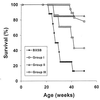Effective treatment of autoimmune disease and progressive renal disease by mixed bone-marrow transplantation that establishes a stable mixed chimerism in BXSB recipient mice
- PMID: 10077628
- PMCID: PMC15886
- DOI: 10.1073/pnas.96.6.3012
Effective treatment of autoimmune disease and progressive renal disease by mixed bone-marrow transplantation that establishes a stable mixed chimerism in BXSB recipient mice
Abstract
Male BXSB mice spontaneously develop autoimmune disease with features similar to systemic lupus erythematosus. To determine whether this autoimmune disease can be treated as well as prevented by bone-marrow transplantation (BMT) and, at the same time, whether the immunity functions of lethally irradiated recipients can be reconstituted fully, male BXSB mice were engrafted with mixed T cell-depleted marrow (TCDM) both from fully allogeneic autoimmune-resistant BALB/c mice and from syngeneic autoimmune-prone BXSB mice, after the onset of autoimmune disease in the recipient mice. BMT with mixed TCDM from both resistant and susceptible strains of mice (mixed BMT) established stable mixed chimerism, prolonged the median life span, and arrested development of glomerulonephritis in BXSB mice. BMT with mixed TCDM also reduced the formation of anti-DNA antibodies that are observed typically in male mice of this strain. Furthermore, mixed BMT reconstituted the primary antibody production in BXSB recipients impressively. These findings indicate that transplantation of allogeneic autoimmune-resistant TCDM plus syngeneic autoimmune-prone TCDM into lethally irradiated BXSB mice can be used to treat autoimmune and renal disease in this strain of mice. In addition, this dual bone-marrow transplantation reconstitutes the immunity functions and avoids the immunodeficiencies that occur regularly in fully allogeneic chimeras after total body irradiation. This report describes an effective treatment of progressive renal disease and autoimmunity by establishing a stable mixed chimerism of TCDM transplantation from allogeneic autoimmune-resistant BALB/c mice plus syngeneic autoimmune-prone BXSB mice into BXSB mice.
Figures




References
-
- Theofilopoulos A N, McConahey P J, Izui S, Eisenberg R A, Pereira A B, Creighton W D. Clin Immunol Immunopathol. 1980;15:258–278. - PubMed
-
- Eisenburg R A, Izui S, McConahey P J, Hang L M, Peters C J, Theofilopoulos A N, Dixon F J. J Immunol. 1980;125:1032–1036. - PubMed
-
- Hudgins C C, Steinberg R T, Klinman D M, Reeves M J P, Steinberg A D. J Immunol. 1985;134:3849–3854. - PubMed
-
- Cherry, Engelman R W, Wang B Y, Kinjoh K, El-Badri N S, Good R A. Proc Soc Exp Biol Med. 1998;218:223–228. - PubMed
Publication types
MeSH terms
Grants and funding
LinkOut - more resources
Full Text Sources
Other Literature Sources
Medical

